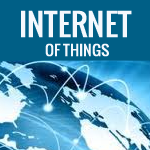An introduction to Internet of things
The Internet, as we all know is a system where computers 
are connected to form a network. We started using
the Internet to share information and slowly
and gradually it has now become a part of our lives.
Now imagine that we take this to a different level altogether.
Imagine every small thing is connected together via some network
using some identification like radio tags or bar codes, etc.
This is the basic concept of “Internet of Things” (IoT). Coined and first used
by Kevin Ashton in the year 1999, this term has now become a reality.
The main idea is that everything can then be tracked and traced and keeping count of what things
are where can be done remotely. Similarly we can remotely control equipment, say switch on the
coffee maker situated in the pantry from the confines of your office.
Interesting? Read on to get more information about the Internet of things.
The main problem that we face today is that today’s internet or sources of information are
still dependent on the humans like you and me who feed and enter information to it.
The main concept of Internet of Things is to make computers and machines independent of
people and the data fed into them by people. If this works well, the Internet of
Things will change the world as you and I know it today.
With IoT we can have kitchens ordering their own food, automated inventory being
updated and maintained, emergency services being called directly by cars after an accident.
It is taking “smart” applications to a different level.
Implementing the IoT
Even as you are reading this article, there are many countries that have invisible
identification tags called Radio Frequency Identification Tags (RFID) on most consumer items.
This will help scan the items and keep a tab on inventory, etc without manual intervention.
But, implementing IoT is not as easy as it sounds. Currently there are different lines of thought –
- IoT can be built on top of the existing Internet, that is, use the existing infrastructure and setup.
This will ensure that the new applications, machines and tools will be built on an established base.
Only those things that are not compatible with the existing Internet technologies will need to be changed. - The other way of doing things is that, one just starts building the framework as more and more
tools and machines get added to it. But this can be unmanageable as the scale increases.
To arrive at a consensus and to decide the best way forward, the European Commission
has set up a committee towards potential regulation of IoT.
The concerns
Though we may feel relieved at machines taking over some of our jobs and getting
more intelligent, there are concerns regarding the security and privacy.
- Security of data – Data is collected by different companies as well as the Government
and we are not sure of the security of this data. Unauthorized people may access this data
and use it for wrong doing. There are meetings and consultations scheduled across the
globe to come at a consensus on the regulatory norms that need to be
put in place to make IoT more secure. - Unnecessary tracking – With RFIDs being installed in most devices, it is getting easier
for the Government and other agencies to monitor your movements. This amounts to a scenario
where the privacy of people is being compromised and people are concerned about this. - No Secrets – The data that your machines pick up may be accessed by others and then secrets,
if any, will be shared with everybody inadvertently.
Internet of Things appears
Though the Internet of Things appears to be the way to move ahead and make life simpler,
technical issues like the framework to be used and personal issues like data security and
privacy need to be addressed before we can avail the benefits.
